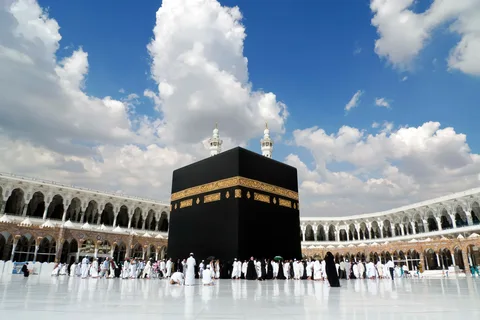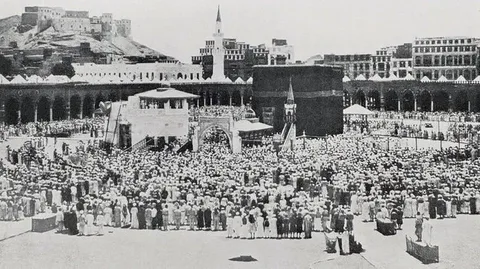Fath Mekkah (The Conquest of Makkah) in 8 Hijri was a pivotal event in early Islamic history that marked the peaceful re-entry of Prophet Muhammad (PBUH) and the Muslims into the city of Makkah, symbolizing the triumph of Islam over polytheism and hostility. This conquest established Islam firmly in the Arabian Peninsula, ending years of conflict and setting the stage for the expansion of the Muslim community.
Historical Background
The Conquest of Makkah in 8 Hijri (630 CE) occurred after years of tension and intermittent battles between the Muslims of Medina and the Quraysh tribe in Makkah. Earlier, the Treaty of Hudaybiyyah, signed in 6 Hijri, had created a ten-year truce between the two parties. However, the treaty was violated when an allied tribe to the Quraysh attacked a tribe allied with the Muslims, giving the Prophet Muhammad (PBUH) a legitimate cause to act against the Quraysh aggression.
The Muslims, numbering around 10,000, marched upon Makkah with well-prepared strategy in the month of Ramadan. The army was disciplined, and the plan aimed for minimal bloodshed, emphasizing a peaceful takeover rather than violent confrontation.
The Strategic March and the Approach to Makkah

In the weeks leading to the conquest, the Prophet Muhammad (PBUH) kept the march secret, surprising the Quraysh. The large Muslim force traveled a route avoiding major settlements and strategic points, ensuring they faced no interference or preemptive attacks.
The patience and discipline of the Muslims were notable, as no large-scale engagements occurred until they reached the outskirts of Makkah. The strategy thus combined psychological tactics of surprise and overwhelming strength to facilitate a peaceful surrender.
Key Events on the Day of the Conquest
When the Muslims arrived near Makkah, the leaders of Quraysh were taken aback by the large Muslim army. The Prophet Muhammad (PBUH) ordered his forces to enter Makkah calmly, forbidding bloodshed and destruction, declaring a general amnesty.
Some key moments include:
-
The Prophet’s entrance to the Kaaba, where he destroyed the idols, symbolizing the eradication of polytheism.
-
The forgiveness granted to many of his former enemies, including the notable leaders of Quraysh.
-
The call for Makkah’s residents to embrace Islam, leading many to convert peacefully.
This magnanimity displayed by the Prophet was crucial in consolidating Islam’s hold over the region and turning former enemies into followers.
Read about: The battle of Bani Qurayzah (5 Hijri)
Religious and Social Impact
The Conquest of Makkah marked a major turning point for Islam. It ended the era of persecution faced by Muslims and established Makkah as the spiritual center of Islam, with the Kaaba as the unified place of worship.
Socially, the conquest united the tribes of Arabia under a common religious and political framework. This unity fostered the expansion of Islamic governance and provided stability across the Arabian Peninsula.
The event also demonstrated the principles of mercy and justice in Islamic governance, as even the arch-enemies were pardoned, setting a precedent for future Islamic leadership.
Political and Military Significance
Politically, the conquest ended the power of the Quraysh polytheists. It facilitated the spread of Islam throughout the Arabian Peninsula without the need for further major military confrontations.
The conquest strengthened the Prophet’s position as both a religious and political leader. It enhanced his influence, allowing more tribes to accept Islam voluntarily.
Militarily, the event showed the effectiveness of strategic planning, discipline, and psychological tactics over brute force. It highlighted Prophet Muhammad’s leadership skills and deep understanding of human nature.
Read more: The battle of Badr Al-Akherah (4 Hijri)
Key Figures During the Conquest
-
Prophet Muhammad (PBUH): The leader whose wisdom and restraint shaped the conquest.
-
Khalid ibn al-Walid: A prominent military commander who played a critical role in the campaign.
-
Umar ibn al-Khattab: Later the second Caliph, participated actively in the conquest and its aftermath.
-
Abu Sufyan: Former adversary who converted to Islam during the conquest, symbolizing the shift in power.
Lessons From Fath Mekkah
The Conquest of Makkah teaches powerful lessons in leadership, mercy, and strategic planning. The restraint shown by the Prophet (PBUH) offers an enduring model of triumph through compassion rather than vengeance.
It also exemplifies the importance of decisive action combined with moral principles, where strength does not erase justice but enforces peace and reconciliation.
FAQs
What caused the Conquest of Makkah in 8 Hijri?
The violation of the Treaty of Hudaybiyyah by the Quraysh and their allied tribes attacking Muslim allies motivated the Prophet to mobilize for the conquest.
How did the Prophet ensure the conquest was peaceful?
He ordered his troops not to harm anyone or destroy property, and he offered a general amnesty which encouraged surrender without resistance.
What happened to the idols in the Kaaba?
The Prophet Muhammad (PBUH) ordered the destruction of all idols inside and around the Kaaba, abolishing polytheistic practices.
Who were some key converts during the conquest?
Notable converts included Abu Sufyan and many former Quraysh leaders who accepted Islam after the conquest.
What was the significance of the Conquest of Makkah?
It established Islam as the dominant faith in Arabia, ended hostilities with the Quraysh, and unified the tribes under a single religious and political leadership.
Conclusion
The Conquest of Makkah in 8 Hijri was a watershed moment in Islamic history. It transformed the religious, political, and social landscape of the Arabian Peninsula by peacefully ending the hostility between the Muslims and the Quraysh. The event underscored the values of forgiveness, strategic wisdom, and unity, cementing the foundation for the expansion of Islam. The Prophet Muhammad’s exemplary leadership during this conquest remains a source of inspiration for Muslim communities and leaders worldwide, embodying the triumph of justice, faith, and reconciliation.

